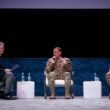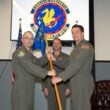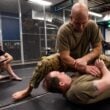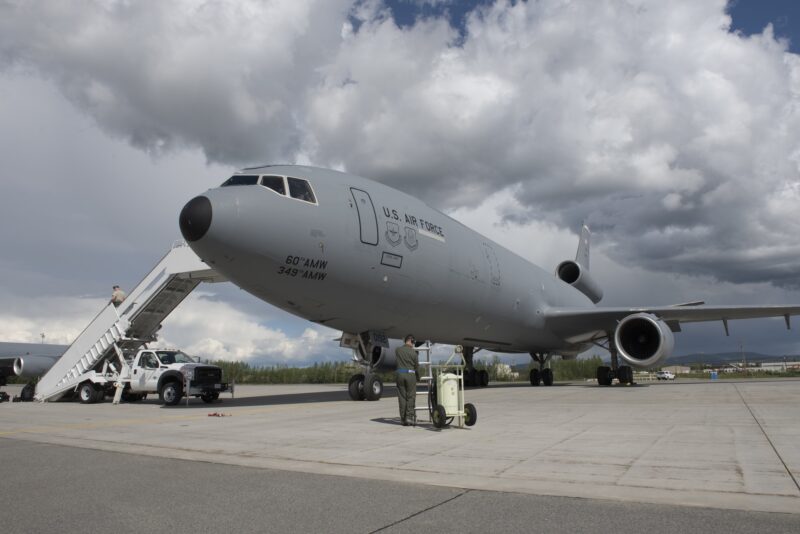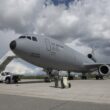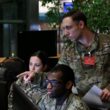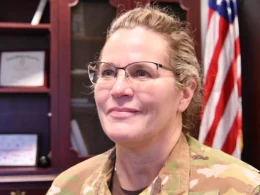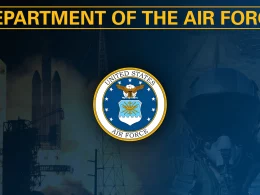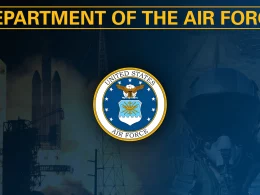TRAVIS AIR FORCE BASE, Calif. —
The October 2023 unit training assembly weekend proved Reserve Citizen Airmen were ready when in flight aircrews from the 70th and 79th Air Refueling Squadrons received a real-world request from Coast Guard District 11 Headquarters based in Alameda, California to aid in a Search and Rescue mission.
During the UTA, call sign ORCA-70 and TOGA-79, two KC-10A Extenders, departed with a full aircrew on board from Travis airfield to participate in planned tanker and receiver training.
After takeoff, the 60th Air Mobility Wing, Travis Command Post received the USCG’s request for assistance upon confirming an active distress beacon near the Oregon/California border, coordinates 41-41.8N 129-31.3W.
“Both aircraft received phone calls from TCP to see if either of us could accept a ‘lat long’, that is to say, proceed to a global positioning satellite fix,” said Capt. Judah Anolick, assistant chief of training and ORCA-70 aircraft commander. “The Coast Guard wanted to know if we could investigate and, if able, help facilitate a rescue.”
“Lat long” is an acronym for latitude-longitude for two sets of numbers that define GPS coordinates north-south and east-west.
Anolick said the flight of two KC-10As and three F-15s from the 142nd Fighter Wing, Oregon Air National Guard Base, Oregon completed their training mission as planned when the SAR call was received. Eight boom operators and the aircraft crews accomplished all the training objectives. The pilots were communicating their statuses when the call came in.
The F-15 fighters fortunately took less gas than initially planned, leaving the KC-10A’s with more fuel for the SAR mission.
TORA-79 was enroute back to Travis after burning all available fuel during the training mission. The crew passed off the latest coordinates, a thorough weather report as the weather conditions were poor, and a report of having heard the emergency locator transmitter (ELT) over the aircraft’s radio; however, there was no sighting of a distressed vessel as reported.
The crew of ORCA-70 communicated with the USCG via satellite call and coordinated an amendment to the filed flight plan. They headed directly to the area of the first distress signal. Two other ELT locations were also detected within a few miles of the original point. ORCA-70’s heading was west.
The pilots coordinated a non-standard descent over the ocean with San Francisco Radio Control via high frequency radios. ORCA-70 initially descended to 6,500 feet and remained in dense cloud cover. Descending to another 3,500 feet and sequentially, an additional 2,500 feet, did not give way to improvements in the weather.
The aircraft commander prepared to lower the altitude down again to 1,500 feet.
“At this altitude, we were still in and out of dense clouds, but we were able to see the ocean for brief periods of time,” said Anolick. “It was raining and very windy, both at our altitude of approximately 45 knot winds and at the surface of the water, with large and plentiful white caps on the surface.”
The flight engineers and additional pilots on board following safety protocols nailed down a good “bingo fuel” level, which was determined to be a minimum of 35,000 pounds needed to safety return to Travis. The report provided from TOGA-79 on its return to the base assisted in the fuel calculations to confirm ORCA 70 could safely fly for one hour on station to support the mission.
“The crew’s strategy was to plot all the previous points received from the USCG and scan the areas of interest for the distressed ship. Despite the continuous rain, dense clouds, and barely discernable surface conditions, crew members took up positions at nearly every available window in the jet to see anything out of the ordinary,” said Anolick.
Navigating five to six passes over the area where ELT signals were picked up, the search yielded nothing. During one of the final pass overs, Staff Sgt. Taylor Dickson, 70 ARS boom operator, called from the back of the jet that he had seen something out of the air refueling operations window.
ORCA-70 marked the point and entered the data into the navigation database to locate the ship again. A few more passes of the available points did not reveal another sighting; however, the crew continued to search and eventually found the ship again.
A picture of the boat’s trajectory starting to emerge, and the SAR team consistently located the vessel on subsequent passes. The aircrew of ORCA-70 gauged the fuel load, and determined the plane could maintain visual contact with the ship for two 360 degree turns, which depending on speed is approximately a five-mile radius. The aircrew radioed in and provided detailed information on the current state of the ship, location of the sighting and other information to the USGC before departing the area.
The 70th ARS crew was forced to leave the site. Bingo fuel had been reached, so it was necessary to return to the base.
“We were grateful to hear that a nearby passenger vessel was enroute to our most recent location. We briefly talked with them directly over our high frequency radios, but quickly lost connection,” said Anolick. “We believed the passenger ship was able to get the rest of our information from the USCG after we lost contact.”
ORCA-70 touched down at Travis AFB and contacted the USCG after arrival. The crew received an updated status regarding the SAR and was informed the passenger ship arrived at the scene. It was reported a single male was aboard the distressed ship, which had taken on water. He was safely recovered.
“I am very proud to have such an exceptional crew despite the day and the long odds. Everyone was willing to make the long drive out over the ocean to do our best to assist in this search and rescue mission,” said Anolick. “We had eyes looking out every window.”
Lt. Col. Jill Sliger, 349th Operations Group commander expressed gratitude to the TPC, “We got word that a life was saved today because of your effective communication to the aircraft we had in the air and to the U.S. Coast Guard…. incredible.”
In a message relayed to the flight crews, the USCG said “We couldn’t have done it without you.”



